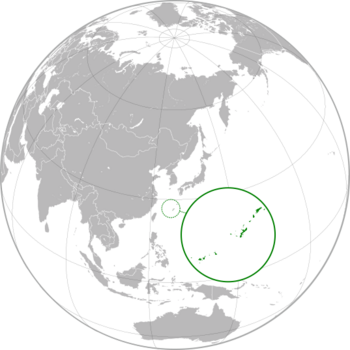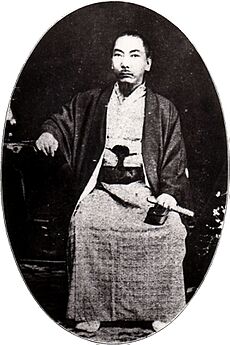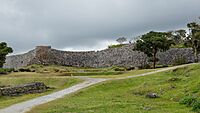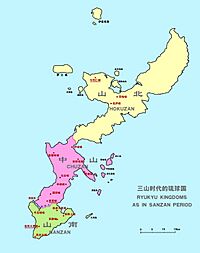History of the Ryukyu Islands facts for kids
The Ryukyu Islands are a chain of islands southwest of Japan. This article tells the story of their past, from ancient times to today.
Contents
What's in a Name? Ryukyu and Okinawa
The name "Ryukyu" comes from old Chinese writings. The earliest mentions of "Ryukyu" were in a Chinese history book from 607 AD. The name means "glazed horn-dragon."
The name "Okinawa" has a less clear origin. It was used in Okinawa itself. An old book of poems mentions a special woman named "Uchinaa." This might mean there was a sacred place called Okinawa. A Chinese monk in the 700s wrote "Okinawa" as "Ajinawa." The current Japanese characters for Okinawa (沖縄) first appeared in a map series in 1702.
Early History of the Ryukyu Islands
Ancient Times: Prehistoric Period
We don't know exactly when people first arrived in Okinawa. The oldest human bones found are from about 32,000 years ago. These include the Yamashita Cave Man and Minatogawa Man. They likely came from China. No stone tools were found with these early human remains.
Shell Mound Culture
The Okinawa shell mound culture is split into two parts. The early part was a time when people hunted and gathered food. They used pottery with wavy designs. Later, people moved closer to the seashore, suggesting they started fishing.
Unlike Japan, rice farming did not start early in Okinawa. It began later in the shell mound age. People in Japan imported shell rings from the Sakishima Islands for jewelry. In these islands, shell axes from 2,500 years ago show influences from Southeast Pacific cultures.
Myths and Early Dynasties
The first history of Ryukyu was written in a book called Chūzan Seikan in the 1600s. It tells the Ryukyuan creation myth. This myth includes the first king, Tenson, and the creation of Noro, who were female priestesses.
The story says a Japanese samurai named Minamoto no Tametomo came to Okinawa. He had a son named Shunten, who became king. Most historians believe this story was made up later to connect Okinawa to Japan. Shunten's family line ended after three kings. Then, Eiso started a new royal family that ruled for five generations.
Gusuku Period: Castles and Trade
Gusuku is the name for the special castles or fortresses in Okinawa. Many gusukus are now World Heritage Sites. After the shell mound culture, farming began around the 12th century. People moved to higher places. This time is called the Gusuku period.
Gusukus might have been holy places, homes surrounded by stones, or castles for leaders. During this time, Okinawa became a busy trading hub in East Asia. Kings like Shunten and Eiso were important rulers. In 1272, the Mongol leader Kublai Khan asked Ryukyu to join his empire, but King Eiso refused.
Three Kingdoms Period
This period, also called the Sanzan-jidai (Three Mountains), lasted from 1322 to 1429. Power slowly came together under the Shō family. Shō Hashi conquered the middle kingdom, Chūzan, in 1404. He then took the northern kingdom, Hokuzan, in 1416. Finally, he conquered the southern kingdom, Nanzan, in 1429. This united the three kingdoms into one Ryukyu Kingdom.
The Chinese Emperor recognized Shō Hashi as the ruler. The Ryukyu Kingdom was independent but paid tribute to China.
The Ryukyu Kingdom (1429–1879)
Quick facts for kids
Ryukyu Kingdom
|
|||||||||||||||||
|---|---|---|---|---|---|---|---|---|---|---|---|---|---|---|---|---|---|
| 1429–1879 | |||||||||||||||||
|
Anthem: "Ishinagu nu uta" (石投子之歌)
|
|||||||||||||||||
 |
|||||||||||||||||
| Status |
|
||||||||||||||||
| Capital | Shuri | ||||||||||||||||
| Common languages | Ryukyuan (native languages), Classical Chinese, Classical Japanese | ||||||||||||||||
| Ethnic groups | Ryukyuan | ||||||||||||||||
| Religion | Ryukyuan religion, Shinto, Buddhism, Confucianism, Taoism | ||||||||||||||||
| Government | Monarchy | ||||||||||||||||
| King (國王) | |||||||||||||||||
|
• 1429–1439
|
Shō Hashi | ||||||||||||||||
|
• 1477–1526
|
Shō Shin | ||||||||||||||||
|
• 1587–1620
|
Shō Nei | ||||||||||||||||
| Sessei (摂政) | |||||||||||||||||
|
• 1666–1673
|
Shō Shōken | ||||||||||||||||
| Regent (國師) | |||||||||||||||||
|
• 1751–1752
|
Sai On (Sai Un) | ||||||||||||||||
| Legislature | Shuri cabinet (首里王府), Sanshikan (三司官) | ||||||||||||||||
| History | |||||||||||||||||
|
• Unification
|
1429 | ||||||||||||||||
|
• Satsuma invasion
|
5 April 1609 | ||||||||||||||||
|
• Reorganized into Ryukyu Domain
|
1872 | ||||||||||||||||
|
• Annexed by Japan
|
27 March 1879 | ||||||||||||||||
| Currency | Ryukyuan, Chinese, and Japanese mon coins | ||||||||||||||||
|
|||||||||||||||||
| Today part of | Japan | ||||||||||||||||
The Golden Age (1429–1609)
In 1429, King Shō Hashi united the three kingdoms. He made Shuri Castle his capital. King Shō Shin (ruled 1477–1526) led the kingdom during a time of peace and wealth. He helped set up the kingdom's government and economy. During his rule, the kingdom also expanded its control to nearby islands like Miyako-jima.
Many Chinese people moved to Ryukyu to work for the government or in business. In 1392, China sent 36 Chinese families to help with sea trade. Many Ryukyuan officials were descendants of these Chinese immigrants. They helped Ryukyu improve its technology and diplomatic ties.
Satsuma's Influence (1609–1871)
In April 1609, the Shimazu clan from Japan's Satsuma region invaded the Ryukyu Kingdom. Three thousand men sailed from Japan. They defeated the Ryukyuans in the Amami Islands and at Nakijin Castle. The Japanese then captured Urasoe Castle and finally Shuri Castle, the capital. King Shō Nei surrendered, famously saying, "life is a treasure." Many valuable cultural items were taken to Japan. The Amami Islands became part of Satsuma in 1611.
After 1609, the Ryukyuan kings became vassals (like a junior partner) of Satsuma. Even though it was called an independent kingdom, the islands were sometimes seen as a Japanese province. Satsuma banned common people from owning swords. This led to the development of Okinawan martial arts, which used everyday items as weapons.
From the 17th century, the Ryukyu kingdom was a tributary of China and a vassal of Japan. This was useful for Japan because China would only trade with countries that paid tribute. So, Ryukyu became a way for Japan to trade with China when Japan had closed most foreign trade. In 1853, American ships led by Commodore Perry visited Ryukyu. In 1871, 54 Ryukyuans were killed in Taiwan after their ship wrecked.
Ryukyu as a Japanese Domain (1872–1879)
In 1872, the Ryukyu Kingdom became a feudal domain of Japan. After Japan's expedition to Taiwan in 1874, Japan's role as protector of the Ryukyuan people was recognized. However, the idea of Ryukyu's independence was partly kept until 1879. In 1878, the islands were listed as paying tribute to Japan. The main island was called "Tsju San." Its main port was open for foreign trade.
The islands produced tea, rice, sugar, tobacco, and silk. They also made cotton, paper, porcelain, and lacquered goods.
Okinawa Prefecture (1879–1937)

In 1879, Japan decided to officially take over the Ryukyu Kingdom. China protested and asked former U.S. President Ulysses Grant to help. One idea was for Japan to take the northern islands, China the southern islands, and the central islands to remain independent. When talks failed, Japan took over the entire Ryukyu archipelago.
The Ryukyu domain was replaced by Okinawa Prefecture. The king, Shō Tai, was forced to move to Tokyo. He was given a noble title in Japan.
Many Ryukyuans were unhappy about being annexed. Japan tried to remove Ryukyuan culture, language, and religion. Public schools only allowed standard Japanese. Students who spoke their own language were shamed by having to wear "dialect speaker" plaques. This helped more people learn Japanese. Later, many Ryukyuans felt proud to be citizens of the Japanese Empire. But some still felt like second-class citizens.
Okinawa and World War II
Before World War II, Japan wanted to make its people feel more united for military reasons. This involved drafting soldiers and using nationalistic messages. Many people in the Ryukyu Islands, even though they had only been full Japanese citizens for a generation, wanted to prove their loyalty.
In 1943, during the war, the U.S. president asked China if it wanted to claim the Ryukyus after the war. China replied that it would be fine with the U.S. and China jointly occupying and later administering the islands under an international organization. On March 23, 1945, the United States began its attack on Okinawa Island. This was the last island before a planned invasion of mainland Japan.
Battle of Okinawa: April 1 – June 22, 1945
The Battle of Okinawa was one of the last big battles of World War II. About 120,000 soldiers died. Okinawa was the only inhabited part of Japan to have a land battle during the war. More than one-third of the civilian population, about 300,000 people, were killed. Many important historical sites, like Shuri Castle, were destroyed.
Americans thought Okinawans would welcome them. But Japanese propaganda made Okinawans fear Americans. Some Okinawans joined militias and fought with the Japanese. This made it hard for Americans to tell soldiers from civilians, leading to more civilian deaths.
Japanese soldiers often hid in caves with civilians, increasing civilian casualties. Japanese soldiers also shot Okinawans who tried to surrender to the Allies. The U.S. used Japanese-Americans who spoke Okinawan to broadcast messages. This led Japanese soldiers to believe Okinawans who didn't speak Japanese were spies, and these Okinawans were often killed.
In the Yaeyama Islands, the Japanese military forced people to evacuate to mountains where malaria was common. Fifty-four percent of the island's population died from hunger and disease.
After the War: U.S. Occupation
After the war, the United States occupied the islands. The U.S. military governed them from 1945 to 1950. Then, the United States Civil Administration of the Ryukyu Islands took over. The Treaty of San Francisco in 1952 officially ended the war. However, American military bases on Okinawa have caused tension between Okinawans and the U.S. military. During the occupation, American soldiers were not subject to Okinawan laws.
U.S. control continued even after the occupation of Japan ended in 1952. The U.S. dollar was the official money, and cars drove on the right side of the road, like in America. In 1978, six years after returning to Japan, Okinawa switched to driving on the left. The U.S. built large army, air force, navy, and marine bases on Okinawa during this time.
On November 21, 1969, U.S. President Nixon and Japanese Prime Minister Eisaku Sato agreed to return the Ryukyus to Japan in 1972. They signed the 1971 Okinawa Reversion Agreement on June 17, 1971. The U.S. returned the islands to Japan on May 15, 1972. This stopped a movement for Ryukyu independence. Under the agreement, the U.S. kept its bases on the island to protect Japan, but these bases were to be nuclear-free. The U.S. military still controls about 19% of the island. The 30,000 American service members are a major part of island life.
Military Bases and Local Concerns
Money from the military bases makes up 5% of Okinawa's economy. Some people believe that if the U.S. left, the island could make more money from tourism. In the 1990s, a committee was set up to ease tensions. They planned to return about 50 square kilometers of land to Japan.
Other complaints are that the military bases disturb Okinawan life. The American military occupies more than a fifth of the main island. Kadena Air Base, the biggest air force base in East Asia, is on the island. Islanders complain about the noise and dangers. In 1959, a jet fighter crashed into a school, killing 17 children. On August 13, 2004, a U.S. military helicopter crashed into Okinawa International University. The U.S. military stopped local police from investigating the crash for six days. Also, unexploded bombs from WWII are still a danger, especially in quiet areas.
Notable People from Ryukyu/Okinawa
- Isamu Chō – A Japanese army officer who supported extreme nationalist ideas.
- Takuji Iwasaki – A Japanese meteorologist, biologist, and historian.
- Uechi Kanbun – The founder of Uechi-ryū, a style of karate from Okinawa.
- Ōta Minoru – A Japanese admiral during World War II.
- Akira Shimada – A governor of Okinawa Prefecture who died in the Battle of Okinawa.
- Mitsuru Ushijima – The Japanese general during the Battle of Okinawa.
- Kentsū Yabu – A famous karate teacher in Okinawa.
- Simon Bolivar Buckner Jr. – An American Lieutenant-General killed during the Battle of Okinawa.
- Ernest Taylor Pyle – An American journalist who died in Okinawa during World War II.
See also
- History of the Amami Islands
- Bernard Jean Bettelheim
- Ethnic issues in Japan
- Himeyuri students
- Iha Fuyū
- Gusuku
- Mudan incident
- Okinawa Prefecture
- Pechin
- Ryukyu Kingdom
- King of Ryukyu
- Ryukyuan people
- Sakishima Islands#History
- Shuri Castle







